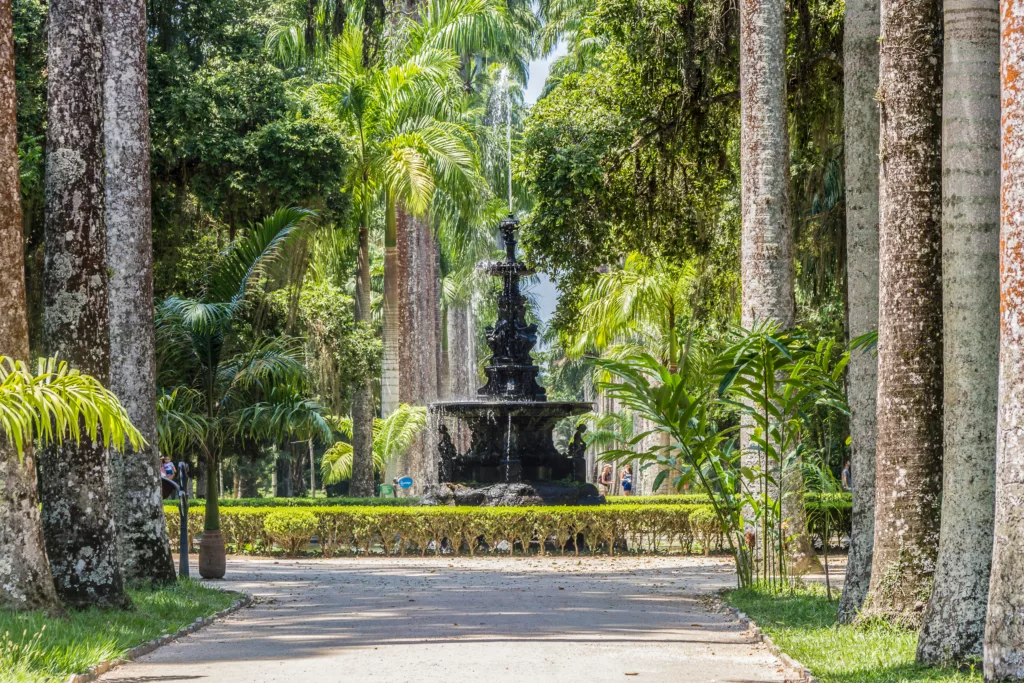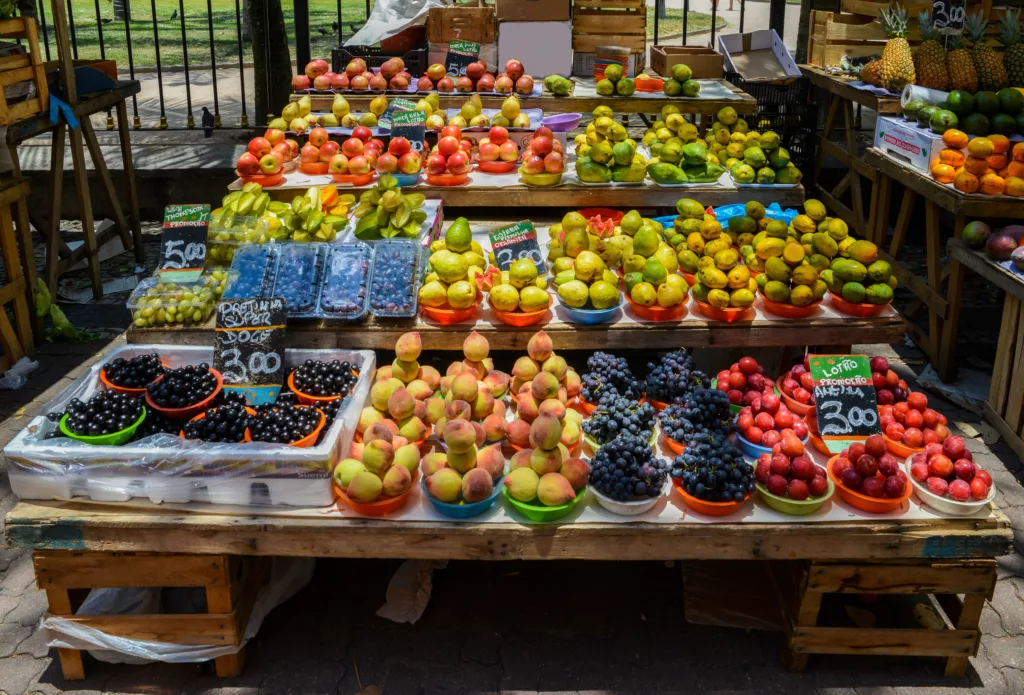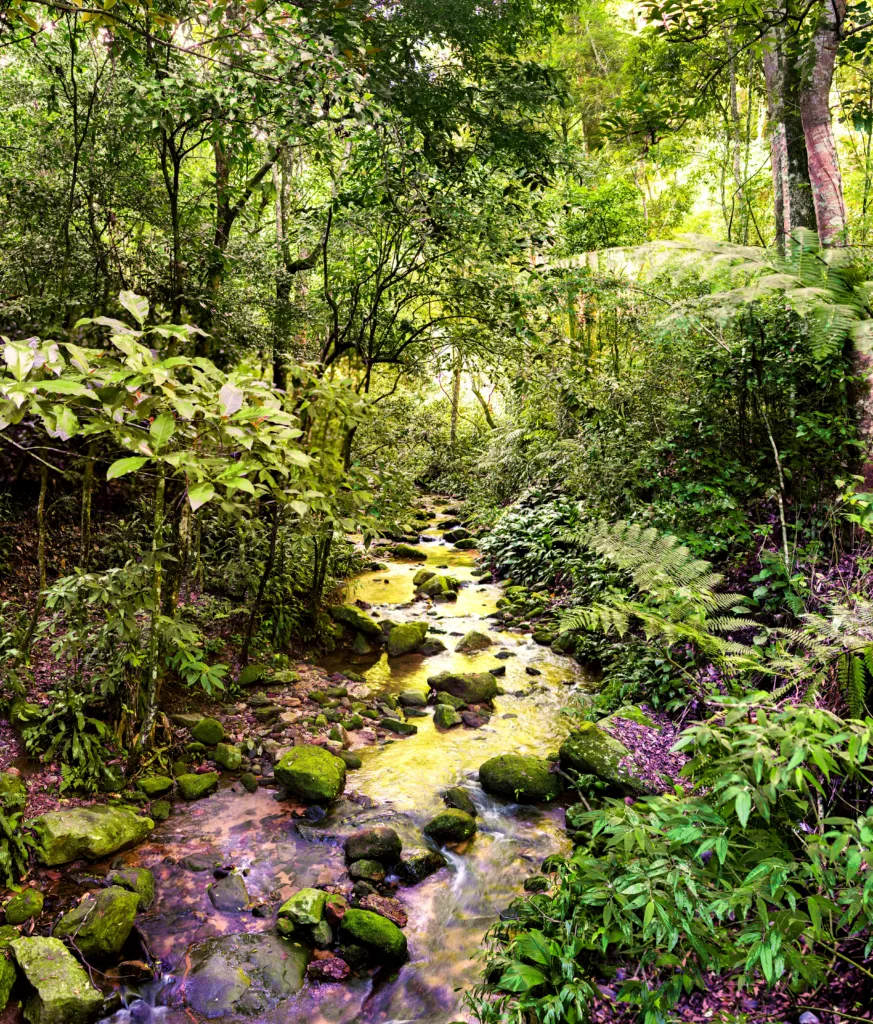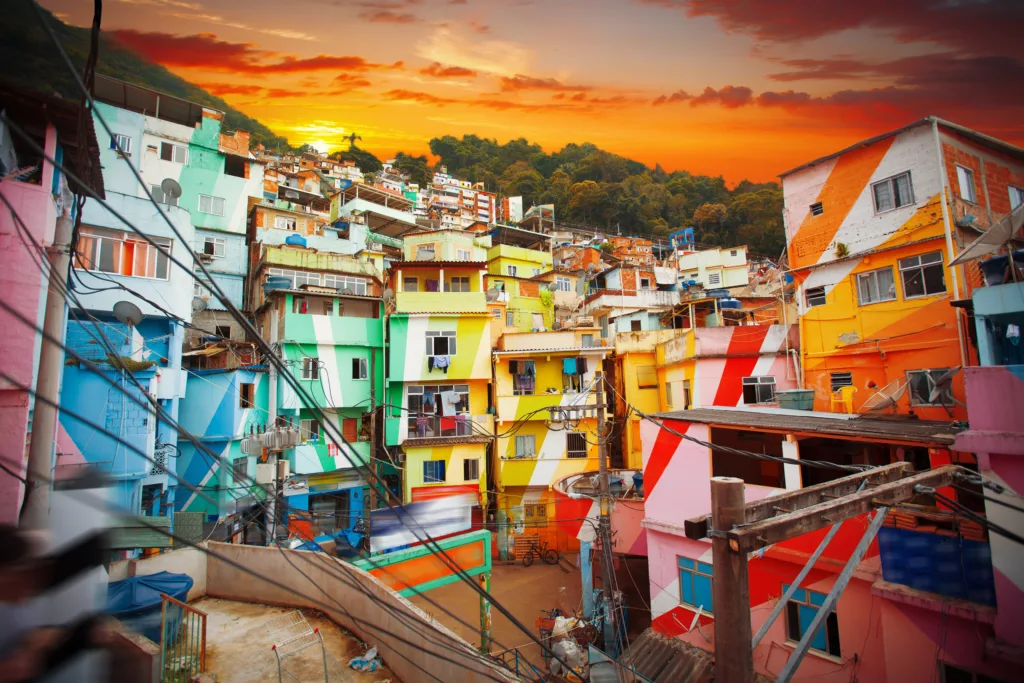Welcome to the rhythmic heart of Brazil, the place where culture, nature, and excitement blend seamlessly together to create a vibrant experience for every traveler – Rio De Janeiro. This stunning city is well-known for its iconic landmarks like the colossal Christ the Redeemer and the picturesque Copacabana Beach. But Rio’s charm goes far beyond these well-trodden tourist paths. It’s in the pulsating rhythm of local samba schools, the tantalizing tastes of street food at Carioca Markets, the artistic enclaves of Santa Teresa, and the peaceful tranquility of the Botanical Garden. It’s a city that invites you to explore, to immerse, and to discover.
With so many things to do and places to see, planning a trip might feel overwhelming. That’s where we come in! We’ve handpicked 17 extraordinary things to do in Rio De Janeiro that balances the famous with the lesser-known, ensuring your experience in this incredible city is nothing short of unforgettable.
1. Visit the Iconic Christ the Redeemer
Perched atop the Corcovado Mountain overlooking the city of Rio de Janeiro, the towering Christ the Redeemer statue is truly an awe-inspiring sight. One of the New Seven Wonders of the World, this iconic landmark, with arms outstretched in an embracing gesture, has become synonymous with the city and is a beacon of Brazilian Christianity.
Designed by French sculptor Paul Landowski and built by the Brazilian engineer Heitor da Silva Costa, the construction of the statue began in 1922 and completed in 1931. The statue, an impressive 38 meters tall, is made of reinforced concrete and covered in triangular soapstone tiles. The choice of material was a deliberate one, aimed at withstanding the city’s harsh weather conditions. Today, the subtle shimmering effect of the sun on the statue’s surface adds to its overall magnificence.
While the statue itself is a marvel, the journey to the top is equally captivating. The Corcovado Mountain is nestled within the Tijuca Forest, the world’s largest urban rainforest, and offers spectacular views of the city and the South Atlantic Ocean.
The experience of standing at the foot of Christ the Redeemer, taking in the panoramic views of Rio, is simply breathtaking. It’s an opportunity to reflect, appreciate, and truly understand why Rio is referred to as the Cidade Maravilhosa – the Marvelous City.
Voyagix Tips
For a memorable visit to Christ the Redeemer, consider these tips:
- Getting There: You can reach the statue via the Corcovado train, van services, or by hiking. Detailed information on each can be found on the official Corcovado website.
- Best Time to Visit: Early morning or late afternoon is less crowded. The view during sunrise or sunset is particularly mesmerizing.
- What to Bring: A camera for the spectacular views, comfortable shoes for the climb, water for hydration, and a hat or sunscreen for protection against the sun.
- Respect the Site: Remember, it’s a religious site. Respect the statue and the surroundings. Avoid littering and be mindful of noise levels.
Whether you’re a history buff, a photography enthusiast, or a spiritual seeker, a visit to the Christ the Redeemer statue provides an enriching, awe-inspiring experience that is a testament to Brazil’s cultural and religious heritage.
2. Relax on Copacabana Beach
A trip to Rio de Janeiro wouldn’t be complete without a visit to the world-famous Copacabana Beach. Extending over 4 kilometers, this crescent-shaped natural wonder is not only a place to soak up the sun but also a cultural hub buzzing with life and energy. Whether it’s a vibrant summer day or a breezy winter afternoon, Copacabana is always brimming with activity.
With a backdrop of rolling waves on one side and a line of art deco buildings on the other, the beach is a spectacle in itself. It’s a stage where Rio’s diverse population comes together, a place where the Rio de Janeiro meets the sea, where sports enthusiasts, sunbathers, vendors, and artists all converge. This blend of people and activities makes Copacabana a lively and colorful display of Rio’s spirit.
The legendary beach is also the host of one of the world’s most spectacular New Year’s Eve celebrations, known as Réveillon. Over two million people, dressed in white, gather to watch the breathtaking fireworks display, listen to live music performances, and celebrate the beginning of a new year.
Running parallel to the beach is the iconic black and white wave-patterned promenade, a design inspired by the Portuguese pavement style. It’s here that you’ll find a plethora of beachfront restaurants, cafes, and shops, offering everything from local Brazilian cuisine to international fare.
Voyagix Tips
For a memorable experience at Copacabana Beach, consider these tips:
- Getting There: The beach is easily accessible by public transportation, including buses, taxis, and the metro. Detailed information can be found on the Rio de Janeiro website.
- Best Time to Visit: Early morning or late afternoon offer less crowded conditions and a chance to witness the stunning sunrise or sunset.
- What to Bring: Bring sunblock, a towel, and some cash for beachside snacks and refreshments. Don’t forget your camera to capture the scenery.
- Beach Etiquette: Remember to respect local customs. Topless sunbathing is frowned upon, and it’s common to see locals playing beach sports – join in if you feel like it!
Whether you’re a beach lover, a sports enthusiast, a foodie, or a photographer, Copacabana Beach offers a unique slice of Rio’s lifestyle, making it an unmissable part of your travel itinerary.
3. Revel in Samba at a Local School
If you’re yearning to delve deeper into Brazil’s rich cultural tapestry, then a visit to a local samba school in Rio de Janeiro is an absolute must. More than just a dance form, samba is the heartbeat of Brazil. It’s a dynamic expression of the country’s history, identity, and vivacious spirit that pulsates through its communities, carrying stories and traditions from generation to generation.
Stepping into a samba school, especially during the pre-carnival period, is like entering a world filled with infectious rhythm, vibrant colors, and an electrifying atmosphere. Here, you’ll witness passionate dancers moving to the compelling beats of the drums, their glittering costumes reflecting the craft and creativity that goes into this spectacular display. Each school, which represents a specific neighborhood in Rio, puts forth a unique theme every year, weaving intriguing narratives through their performances.
But it’s not just a spectacle to watch; it’s an experience to partake in. Many schools welcome visitors to join their rehearsals, offering a chance to learn the mesmerizing dance moves of samba. Dancing alongside locals, you’ll soon find yourself swept up in the rhythm, the energy, and the camaraderie that make these nights unforgettable.
Voyagix Tips
For an unforgettable samba experience, consider these tips:
- Choosing a School: Some of the most renowned samba schools include Mangueira, Salgueiro, and Beija-Flor. You can find more information and schedules on their official websites.
- Getting There: Depending on the location of the school, you can take a taxi or use public transportation.
- What to Wear: Comfortable clothing and footwear are recommended, as you’ll likely be on your feet, dancing and moving around.
- Safety Tips: As these schools are often in crowded, local neighborhoods, be mindful of your belongings and avoid carrying valuable items with you.
Whether you’re a dance enthusiast, a cultural explorer, or simply a traveler seeking unique experiences, a visit to a samba school offers a captivating, authentic glimpse into the soul of Brazil. Let the rhythm guide you, let the energy inspire you, and let the samba experience be a highlight of your trip to Rio de Janeiro.
4. Ride the Cable Car up Sugarloaf Mountain
Seeking a view that will take your breath away? Then you cannot miss the journey up to Sugarloaf Mountain. This iconic granite peak, standing at the mouth of Guanabara Bay, is a definitive highlight of Rio de Janeiro’s skyline. Offering a panoramic vista of the city and the South Atlantic Coast, the mountaintop promises an unforgettable sightseeing experience.
What makes the trip even more exciting is the means of getting there – a cable car ride. The Sugarloaf Cable Car, or “Bondinho” as locals call it, is a two-stage cable car trip, offering riders an adventure and a spectacular view all in one go. The first leg of the journey takes you to the top of Morro da Urca, a lower peak with fantastic views, while the second leg takes you to the summit of Sugarloaf Mountain itself.
The journey up, as you ascend above the city, is an exhilarating experience. You’ll get an aerial view of some of Rio’s famous landmarks, including the Christ the Redeemer statue, Copacabana Beach, and the sprawling cityscape against the backdrop of the Atlantic Ocean. The vista becomes especially magical at sunset when the sky’s hues paint the city in warm colors.
Voyagix Tips
For a spectacular Sugarloaf Mountain experience, consider these tips:
- Getting There: You can reach the base station by bus, taxi, or Uber.
- Best Time to Visit: Visit just before sunset to enjoy the breathtaking view as the sun dips below the horizon, illuminating the sky with brilliant colors.
- What to Bring: Don’t forget your camera! It’s also a good idea to bring a light jacket as it can get chilly at the top, especially in the evening.
- Buy Tickets Online: To avoid long lines, consider purchasing your cable car tickets online on the official website.
Whether you’re a seasoned explorer, a photography lover, or just a tourist seeking incredible views, a trip to Sugarloaf Mountain is a memorable experience that encapsulates the grandeur and beauty of Rio de Janeiro.
5. Explore the Colorful Santa Teresa Neighborhood
For those in search of a unique perspective on Rio de Janeiro, the historic and bohemian neighborhood of Santa Teresa provides a charming diversion from the city’s more traditional tourist spots. Perched atop a hill overlooking downtown Rio, Santa Teresa, with its winding streets, colorful old mansions, and vibrant artistic scene, is a window into the city’s past and a thriving hub of contemporary culture.
Santa Teresa’s origins trace back to the 18th century, and its architectural beauty reflects this rich history. Cobblestone streets, adorned with street art and murals, meander through the neighborhood, each turn revealing eclectic boutiques, galleries, and workshops of local artists. The neighborhood is also home to the iconic yellow tram, or “Bonde,” the oldest operating electric tram in South America. A ride on this historic vehicle is like a step back in time.
Known for its gastronomic scene, Santa Teresa boasts a variety of restaurants and cafes, offering a blend of traditional Brazilian cuisine and international fare. Amidst the neighborhood’s lively music scene, you’ll often hear the rhythms of samba and bossa nova wafting from bars and music clubs, adding to the bohemian vibe.
Exploring Santa Teresa offers a delightful contrast to Rio’s bustling city life and crowded beaches. It’s a place where art, history, and culture mingle, creating an environment that’s both refreshing and enchanting.
Voyagix Tips
For a delightful Santa Teresa experience, consider these tips:
- Getting There: You can reach Santa Teresa by bus or taxi.
- Best Time to Visit: Weekdays are generally quieter and less crowded than weekends. For a lively atmosphere, visit during the annual Santa Teresa Art Fair, when the neighborhood comes alive with artistic displays and music.
- What to Wear: Comfortable walking shoes are a must, as the neighborhood is known for its hilly terrain and cobblestone streets.
- Stay Safe: As with any city, be mindful of your belongings and surroundings. It’s advisable to explore the neighborhood during daylight hours.
Whether you’re an art enthusiast, a history buff, a food lover, or simply a curious traveler, a stroll through Santa Teresa promises a captivating journey filled with character, creativity, and charm.
6. Discover the Lush Botanical Garden
For a tranquil escape from the hustle and bustle of Rio de Janeiro, a visit to the city’s renowned Botanical Garden, or Jardim Botânico, is highly recommended. Spread across 350 acres, this enchanting oasis is home to a remarkable collection of over 6,000 different species of tropical and subtropical plants and trees, including more than 900 varieties of palm trees.
Established in 1808 by King John VI of Portugal, the garden initially served to acclimatize spices like nutmeg, pepper, and cinnamon imported from the West Indies. Today, it stands as a UNESCO biosphere reserve, serving both as a research institute and a public park.
The Botanical Garden is divided into several sections, each offering a unique exploration of the world’s flora. Marvel at the sight of the stunning Orchid House, home to thousands of exotic species, or take a serene stroll along the Avenue of Royal Palms, a dramatic avenue lined with 134 palm trees. In the midst of vibrant flower beds and lush foliage, you’ll find tranquil ponds filled with water lilies, Japanese gardens, and a sensory garden designed for the visually impaired.
Beyond its plant life, the Botanical Garden is also a haven for wildlife, especially birds. More than 100 species have been recorded here, making it a fantastic location for birdwatching. Amidst the flora and fauna, you’ll also discover historic monuments, fountains, and an old gunpowder factory.
Voyagix Tips
For a serene visit to Rio’s Botanical Garden, consider these tips:
- Getting There: The garden is easily accessible by bus, metro, or taxi.
- Best Time to Visit: The garden is open every day. Early morning and late afternoon are usually quieter and perfect for birdwatching.
- What to Bring: Bring a hat and sunscreen for protection against the sun, and a water bottle to stay hydrated. Don’t forget your camera!
- Buy Tickets Online: To avoid lines, you can buy your tickets in advance on the Botanical Garden’s official website.
Whether you’re a nature lover, a plant enthusiast, or simply seeking a peaceful retreat, Rio’s Botanical Garden offers an immersive experience amidst the city’s natural and historical heritage.
7. Visit the Museum of Tomorrow
For a journey that transcends time and space, venture to Rio de Janeiro’s innovative Museum of Tomorrow. Located in the revitalized Porto Maravilha area, this science museum is not your ordinary exhibition space. Its interactive and immersive displays, curated to explore the possibilities of constructing a sustainable future, make it a truly unique attraction in the heart of the city.
The museum, designed by the celebrated Spanish architect Santiago Calatrava, is itself a testament to sustainability. Its striking design incorporates solar panels that move with the sun and a cooling system that uses water from the nearby Guanabara Bay, embodying the same principles of sustainability that it seeks to promote.
Inside the Museum of Tomorrow, visitors are invited to contemplate five major areas: Cosmos, Earth, Anthropocene, Tomorrow, and Us. These areas are explored through a variety of multimedia exhibits and installations, interactive games, films, and experiential activities, all designed to challenge and inspire. The journey takes you from the Big Bang to visions of the future, weaving a narrative about the Anthropocene – the current geological age viewed as the period during which human activity has been the dominant influence on climate and the environment.
Voyagix Tips
For an inspiring visit to the Museum of Tomorrow, consider these tips:
- Getting There: The museum is located in the city center and can be reached by bus, taxi, or the VLT light rail system.
- Best Time to Visit: The museum can get crowded, especially on weekends. Visit early on a weekday for a quieter experience.
- Interactive Displays: Many displays are interactive and can be accessed through a personal device. Downloading the museum’s app beforehand will enhance your visit.
- Ticket Information: You can buy tickets at the museum, but to avoid waiting in line, consider purchasing them online through the Museum of Tomorrow’s official website.
Whether you’re a science enthusiast, a future thinker, or simply a curious traveler, a visit to the Museum of Tomorrow offers a thought-provoking exploration of where humanity has been, where it is now, and where it might be going.
8. Savor Street Food at the Carioca Markets
For food lovers exploring Rio de Janeiro, a visit to a Carioca Market is a delightful indulgence for the senses. The term “Carioca” refers to anything related to the city of Rio, and these local markets are certainly a testament to the city’s vibrant food culture. From street food vendors to fresh produce stalls, each market brims with a multitude of culinary treasures waiting to be discovered.
As you weave through the bustling stalls, the aroma of acarajé — a deep-fried ball of black-eyed pea dough filled with shrimp — might lure you in. A culinary gift from Bahia, this Afro-Brazilian delicacy is a savory sensation, often accompanied by vatapá (a creamy paste made from shrimp, bread, coconut milk, and palm oil) and a refreshing tomato salad. It’s a must-try for any seafood lover.
For a sweet ending, look out for brigadeiros, Brazil’s beloved chocolate treat. These fudgy, truffle-like confections, made from condensed milk, butter, and cocoa powder, are often coated in chocolate sprinkles and are as much a joy to look at as they are to eat. They’re the perfect portable dessert to enjoy as you continue exploring the market.
Alongside these delights, the Carioca Markets also offer a variety of fresh fruits, vegetables, cheeses, meats, and fish. It’s a place where locals and tourists alike come to savor the flavors of Rio and to experience the city’s lively food culture firsthand.
Voyagix Tips
To make the most of your Carioca Market experience, consider these tips:
- Getting There: Rio’s markets are dotted throughout the city. Some popular ones include the Ipanema Farmers Market and the São Cristóvão Fair. Local transport options like buses and taxis can get you there.
- Best Time to Visit: Markets are usually busiest and at their best in the mornings. For the freshest produce, get there early.
- Try Local Delicacies: Don’t miss out on local favorites like acarajé and brigadeiro. Some vendors may offer free samples, but remember to carry cash as many stalls don’t accept cards.
- Remember Hygiene: When eating street food, check that food is prepared and served hygienically.
A visit to a Carioca Market offers an authentic and tantalizing introduction to Rio’s vibrant culinary scene. It’s a treat for the senses and an absolute must for foodies!
9. Hike in the Tijuca National Park
For nature enthusiasts visiting Rio de Janeiro, a hike in Tijuca National Park is an absolute must. This colossal urban rainforest, among the largest in the world, stretches over 32 square kilometers. It is a verdant gem in the heart of the city, a breathtaking testament to Brazil’s commitment to conservation and a haven for diverse wildlife.
The park, predominantly replanted in the second half of the 19th century after extensive coffee farming had decimated the land, today stands as a lush paradise. As you traverse the various trails, you’ll find yourself surrounded by towering trees, listening to the symphony of local birds and waterfalls, and catching glimpses of small mammals, monkeys, and exotic insects.
Among the park’s highlights are the Pico da Tijuca, the highest peak in the park offering panoramic views of Rio, and the enchanting Taunay waterfall. Also worth visiting is the Mayrink Chapel with murals painted by Brazilian modernist artist Cândido Portinari.
Beyond its natural wonders, Tijuca National Park is also home to several attractions like the Christ the Redeemer statue, located at the Corcovado mountain within the park’s limits.
Voyagix Tips
For an unforgettable hike in Tijuca National Park, consider these tips:
- Getting There: The park is located in the city and can be reached by bus or taxi. There are several entrances, so plan your route based on the areas you want to explore.
- Best Time to Visit: The park is open every day. Mornings tend to be cooler and less crowded.
- Prepare for Your Hike: Wear sturdy footwear, bring a reusable water bottle, snacks, a hat, sunscreen, and insect repellent. Pack a raincoat too, as showers are frequent.
- Respect the Park: Stay on designated paths, don’t disturb wildlife, and carry out any trash. This helps preserve the park’s natural beauty for future visitors.
Whether you’re an avid hiker, a nature lover, or simply a traveler in search of tranquility, a journey into Tijuca National Park offers a rich and rejuvenating outdoor adventure amidst Rio’s bustling cityscape.
10. Explore the Morrinho Project
Delve into a unique aspect of Rio’s culture by visiting the Morrinho Project. What began as a simple childhood game has transformed into a significant social and cultural initiative that provides insightful perspectives into life in Rio’s favelas. This impressive model city, constructed from bricks and various recycled materials, represents an authentic miniature favela.
The project started in the Pereirão favela in 1997 when local children, seeking to escape from the harsh realities of their surroundings, built a playful replica of their community. The result was a vibrant, miniaturized cityscape complete with buildings, vehicles, and tiny human figures, all created from repurposed materials.
Today, the Morrinho Project serves multiple purposes. It is a tool for social change, an art installation, a film set, and a symbol of hope and creativity in challenging environments. It not only inspires the local community but also attracts global attention, having been showcased in art exhibitions and cultural festivals around the world.
Visiting Morrinho Project provides an engaging way to understand the social complexities of life in a favela. It invites you to see beyond the stereotypes, to appreciate the creativity that thrives amidst adversity, and to consider the diverse narratives that define Rio.
Voyagix Tips
For a meaningful visit to the Morrinho Project, consider these tips:
- Getting There: The Morrinho Project is located in the Pereirão favela. It’s recommended to use a taxi or hire a local guide for navigation and safety.
- Respect the Community: Keep in mind that the project is in a residential area. Be respectful of the community and follow any guidelines provided.
- Guided Tours: Guided tours are available and are a great way to learn more about the project and the community. You can contact the project directly to arrange a tour.
- Support the Project: Consider purchasing a souvenir or making a donation to support the project’s ongoing work.
Visiting the Morrinho Project offers a unique, enriching experience, allowing you to engage with Rio’s culture and community in an authentically impactful way.
11. Attend a Football Match at Maracanã Stadium

Immerse yourself in the heartbeat of Brazil by attending a football match at the iconic Maracanã Stadium. Known officially as Estádio Jornalista Mário Filho, but fondly referred to as Maracanã after the Rio neighborhood it resides in, this stadium is a place of legend. With a capacity of almost 79,000 spectators, it stands as a grand monument to Brazil’s undying passion for football.
Built for the 1950 World Cup, Maracanã has witnessed many historic moments in football history, including Pelé’s 1,000th goal and the heart-wrenching “Maracanazo” defeat of Brazil’s national team by Uruguay in the 1950 World Cup final. As you sit in the vast arena, you can almost feel the echoes of past triumphs, losses, and spectacular displays of skill.
Visiting Maracanã is not merely about watching a game; it’s about experiencing the electrifying atmosphere that sweeps through the crowd with every pass, goal, and save. It’s about joining the chorus of cheering fans, feeling the rhythmic beat of drums, and being swept up in the vibrant display of team colors. Whether you’re a football fan or not, the raw passion and energy of a game at Maracanã is something every traveler should experience.
Voyagix Tips
For an unforgettable experience at Maracanã Stadium, consider these tips:
- Getting There: The stadium is well-connected by Rio’s metro and bus lines. The closest metro station is Maracanã.
- Ticket Purchase: You can buy tickets online or at the stadium. Remember, matches can sell out quickly, especially during important tournaments, so booking in advance is recommended.
- Arrive Early: Arriving early allows you to soak in the pre-game atmosphere and find your seat comfortably.
- Stadium Tours: Consider taking a guided tour of the stadium on non-match days to learn about its history and see areas usually inaccessible to the public.
Watching a match at Maracanã Stadium allows you to feel Brazil’s heartbeat, revealing the passion for football that resonates deeply within Brazilian culture. It’s an encounter that transcends sport, providing a truly immersive experience of Rio’s vibrant spirit.
12. Take a Boat Tour of Guanabara Bay
For a refreshing perspective on Rio de Janeiro, embark on a boat tour of Guanabara Bay. As the second largest bay in Brazil, it offers a unique vantage point to appreciate the city’s stunning landmarks, including the famous Sugarloaf Mountain and Christ the Redeemer.
The bay, discovered in 1502 by Portuguese explorers, is steeped in history and is an important symbol of Rio. A boat tour here doesn’t only offer mesmerizing vistas, it also provides a glimpse into the city’s rich past. As you glide over the calm waters, you can marvel at the vibrant cityscape, the sweeping beaches, and the lush, green mountains that characterize Rio’s landscape.
Perhaps the most spectacular part of a boat tour in Guanabara Bay is the views it offers of two iconic landmarks: the towering Christ the Redeemer and the uniquely shaped Sugarloaf Mountain. From the bay, you can see these marvels in all their glory, set against the backdrop of the city and the sky. Whether you embark on a daytime tour or choose to sail at sunset, these sights are nothing short of spectacular.
Voyagix Tips
For an unforgettable boat tour of Guanabara Bay, consider these tips:
- Booking a Tour: Various companies offer tours of Guanabara Bay. It’s recommended to book in advance. Check out Viator for options.
- Timing Your Visit: Both morning and sunset tours offer unique experiences. Morning tours let you enjoy the calm bay under the warm sun, while sunset tours offer a romantic ambiance with the city bathed in golden hues.
- Packing Essentials: Don’t forget your camera for capturing the stunning views. Also, pack sunscreen and a hat to protect from the sun, and a light jacket for cooler evening temperatures.
- Sea-Sickness: If you’re prone to seasickness, consider taking precautions before your trip. The waters of the bay are usually calm, but it’s always better to be prepared.
Whether you’re a history enthusiast, a photography lover, or a sightseeing adventurer, a boat tour of Guanabara Bay offers a unique way to appreciate the awe-inspiring beauty of Rio de Janeiro.
13. Discover Art at the Museu de Arte do Rio
Immerse yourself in a world of creativity and expression at the Museu de Arte do Rio (MAR), or Rio Art Museum. Located in the heart of the revitalized Porto Maravilha district, MAR is a beacon of local and international art and a must-visit for art enthusiasts and curious travelers alike.
Opened in 2013, MAR quickly became an integral part of Rio’s cultural landscape. The museum’s innovative architecture – a combination of the classic and modern – reflects the dynamism and diversity of the art it houses. Its collection encompasses a variety of mediums and styles, showcasing works from both Brazilian and international artists.
Each exhibit at MAR is meticulously curated, creating immersive narratives that explore different aspects of art, history, and society. The museum is committed to education and inclusivity, making it not only a space to appreciate art but also to engage with and learn from it.
From the museum’s viewing terrace, visitors can also enjoy a panoramic vista of the bay and the surrounding cityscape. This fusion of art, history, and stunning views makes a visit to MAR a memorable experience.
Voyagix Tips
To make the most of your visit to Museu de Arte do Rio, consider these tips:
- Plan Your Visit: Check the official MAR website for the latest exhibits, opening hours, and ticket information. Buying tickets online in advance can help avoid queues.
- Guided Tours: Guided tours provide in-depth insights into the exhibits. They are usually included in the ticket price but check in advance to confirm.
- Take Your Time: The museum’s diverse collection is best enjoyed at a leisurely pace. Plan to spend at least a few hours exploring.
- Visit the Cafe: MAR’s café is a lovely spot to relax and enjoy some local cuisine while taking in the bay views.
At Museu de Arte do Rio, you can delve into the vibrant world of art, engaging with expressive creations that reflect and challenge our understanding of culture, history, and the human experience. It’s a captivating journey that enriches your Rio adventure with artistic wonder.
14. Take a Favela Tour
Step off the beaten track and explore the resilience and vibrancy of Rio’s community with a guided tour of one of the city’s favelas. These densely populated, informal urban settlements are a significant part of Rio’s cultural fabric, providing a lens into the diversity, creativity, and tenacity of its residents.
While favelas often make headlines for the wrong reasons, these communities are also home to compelling narratives of perseverance, social entrepreneurship, and cultural richness. A guided tour of a favela allows you to witness this firsthand, bringing you face-to-face with the realities, challenges, and triumphs of life in these neighborhoods.
These tours are typically led by local guides, giving you an authentic insight into favela life. They take you through narrow alleys lined with colorful homes, introduce you to friendly locals, and provide opportunities to appreciate the striking graffiti art and stunning city views that many favelas offer. These tours also often support local community projects, making them a responsible way to explore this part of the city.
Voyagix Tips
For a respectful and enlightening favela tour, consider these tips:
- Choosing a Tour: Ensure you choose a tour operator that operates ethically and benefits the local community. Companies like Favela Tour are well-regarded.
- Respectful Behaviour: Remember you are a guest. Respect residents’ privacy and ask before taking photographs.
- Dress Appropriately: Dress modestly and avoid flashy jewelry to respect local norms and for your safety.
- Support Local Businesses: Consider purchasing handicrafts or food from local vendors as a way to support the local economy.
A guided tour of one of Rio’s favelas provides a unique perspective on the city’s diverse culture and indomitable spirit. It’s a compelling exploration that highlights the lesser-seen side of Rio, revealing the resilience and vibrancy that exists within these communities.
15. Visit the Rio Star Ferris Wheel
For a bird’s eye view of the city, head over to the Rio Star Ferris Wheel, the tallest Ferris wheel in Latin America. Standing at an impressive 88 meters high, it provides a sweeping panorama of Rio de Janeiro’s iconic skyline, making it an absolute must-see for those seeking an unparalleled vista of this vibrant city.
Located in the heart of Rio’s revitalized port area, the Ferris wheel offers breathtaking views of the city’s most iconic landmarks including Sugarloaf Mountain, Christ the Redeemer, the Guanabara Bay, and the vibrant samba district of Lapa. As you slowly ascend, you’ll feel the excitement build as the view unfolds in front of you – the diverse cityscape, the glittering waterways, and the lush, green mountains.
Each of the 54 cabins of the Rio Star can accommodate up to six people, ensuring a comfortable ride for everyone. Whether you choose to ride during the day or in the evening, the experience is unforgettable. A daytime ride offers clear, expansive views of the city under the bright Rio sun, while an evening ride treats you to a twinkling, romantic panorama of the city lights.
Voyagix Tips
To enjoy the best of the Rio Star Ferris Wheel, consider these tips:
- Plan Your Visit: You can find the latest information on opening hours and ticket prices on the official Rio Star website. Booking tickets online in advance can save time.
- Best Time to Visit: For the best experience, consider visiting during off-peak hours to avoid crowds. The views are spectacular at all times, but sunset rides are particularly popular.
- Weather: As the attraction is outdoors, the weather can affect visibility. Clear, sunny days offer the best views.
- Take Your Time: The ride lasts approximately 15 minutes. Take your time to absorb the stunning views and capture memorable photos.
The Rio Star Ferris Wheel is a thrilling experience that gifts you with a stunning 360-degree view of Rio’s iconic cityscape. It’s an unforgettable way to see the Rio de Janerio in all its glory, making it an absolute must-do when in Rio de Janeiro.
16. Join a Forró Dance Class
Embrace the rhythm and spirit of Brazil by joining a Forró dance class. Originating from the Northeast of Brazil, Forró is a lively, social dance style that captures the energy and joy of Brazilian culture. Whether you’re a seasoned dancer or have two left feet, joining a Forró class is a memorable way to immerse yourself in the local culture.
Forró is more than just a dance style; it’s a cultural phenomenon that brings people together. Classes usually begin with basic steps and rhythms, before progressing into partner work. The lively, upbeat music, combined with the inclusive atmosphere, makes Forró classes an energetic and fun-filled experience.
Forró dance is marked by its close partner connection, playful footwork, and flowing spins. While it might seem complex to a beginner, it’s actually very accessible, even to those who have never danced before. The welcoming community and enthusiastic teachers ensure that everyone feels included and has fun learning the steps.
Voyagix Tips
For a fun-filled Forró dance class, consider these tips:
- Finding a Class: Classes are available in various dance studios and cultural centers across the city.
- Attire: Dress in comfortable clothing that allows for movement. For footwear, choose something with a smooth sole to make it easier to spin and slide on the dance floor.
- Open Mind: Forró is all about connection and joy. Don’t worry about getting the steps perfect, focus on enjoying the music and the company of your dance partner.
- Social Dance: Many places host Forró social dances or “Forró pé de serra” where you can practice what you’ve learned. It’s a great way to meet locals and immerse yourself in the culture.
Joining a Forró dance class is a thrilling, immersive way to experience the energy and joy of Brazilian culture. So, let loose, embrace the rhythm, and dance your heart out in the heart of Rio de Janeiro.
17. Visit the Modernist House at Casa das Canoas

Step into Brazilian architectural history with a visit to the Casa das Canoas. Brazil’s renowned architect Oscar Niemeyer designed this building as his own residence in 1951, and it is celebrated as a masterpiece of modernist architecture. Nestled in the lush greenery of the Tijuca Forest, Casa das Canoas exhibits the seamless integration of architecture and nature, a key principle of Niemeyer’s works.
Constructed with curves and fluid lines that mirror the surrounding landscape, Casa das Canoas is considered one of Niemeyer’s most significant works. Its open plan layout, expansive glass walls, and integration with the surrounding forest are all reflective of Niemeyer’s unique architectural style. The house is minimalist yet elegant, and every corner of the house offers a new perspective of the enchanting surroundings.
The name ‘Casa das Canoas’ derives from the rock formation near the swimming pool that is reminiscent of canoes. The house is filled with design elements that blend the indoor and outdoor spaces, such as the natural rock incorporated into the living area and the free-form swimming pool that emulates a natural pond. It’s not just a house; it’s a living sculpture, a tribute to the possibilities of modern architecture.
Voyagix Tips
To make the most of your visit to Casa das Canoas, consider these tips:
- Visiting Hours: Check the official Niemeyer Foundation website for the latest information on visiting hours and admission prices.
- Guided Tours: Opt for a guided tour to gain in-depth insight into the architectural details and history of the house.
- Respect the Premises: As a historical site, it’s important to respect the premises. Please refrain from touching the furniture and structures.
- Photography: Photography is permitted, but flash and professional cameras are restricted. Check the rules before you visit.
A visit to Casa das Canoas is a journey into the visionary mind of Oscar Niemeyer and the world of Brazilian modernist architecture. It’s a hidden gem of Rio that should not be missed by architecture and history enthusiasts.
Conclusion
As we wrap up our journey through the captivating city of Rio De Janeiro, it’s easy to see why this metropolis draws in travelers from around the world. From the moment you arrive, Rio invites you to delve deeper, to go beyond the typical tourist trails, and to explore its diversity, its passion, and its beauty.
Whether you’re soaking up the sun on Copacabana Beach, savoring the tantalizing tastes of local street food, exploring the hidden corners of Santa Teresa, or basking in the tranquility of the Botanical Garden, every moment in Rio is an opportunity for a new adventure. But remember, exploring Rio isn’t just about ticking off a list. It’s about immersing yourself in its culture, understanding its history, and appreciating its people.
Whether it’s your first time visiting or your hundredth, there’s always something new to discover. So don’t just visit Rio, experience it. Take the time to uncover its hidden gems, dance to its rhythm, and let its vibrant spirit captivate you. After all, that’s what makes travel truly memorable.
















